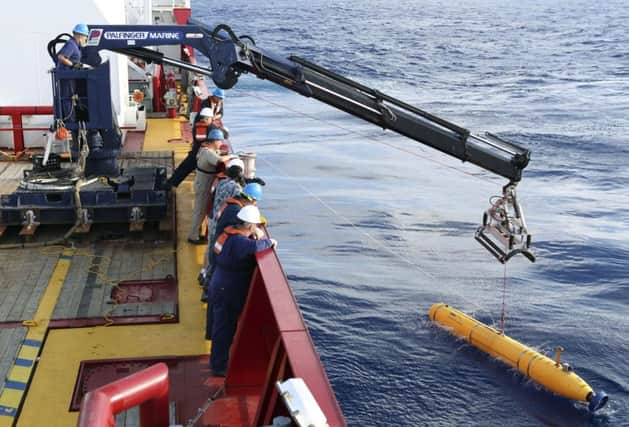Hunt for missing Malaysian jet’s signal delayed


Search crews sent the US Navy’s Bluefin 21 into the depths on Monday to begin scouring the seabed for the missing Malaysia Airlines Boeing 777 after failing to detect any new signals – hoped to be from its black boxes – for six days.
But the 16-hour mission was cut short when the unmanned sub, which is programmed to remain 100ft above the seabed, entered a patch that was deeper than its maximum operating depth of 15,000ft, the search co-ordination centre and the US navy said. A built-in safety feature returned the Bluefin to the surface undamaged, they said.
Advertisement
Hide AdAdvertisement
Hide AdThe data collected by the sub was later analysed and no sign of the missing plane – which vanished en route from Kuala Lumpur to Beijing on 8 March with 239 people on board – was found, the US navy said. Crews were shifting the Bluefin’s search area away from the deepest water and hope to send it back on another mission.
Search authorities had known the primary search area for Flight MH370 was near the limit of the Bluefin’s dive capabilities. Deeper diving submersibles have been evaluated, but none is yet available to help.
A safety margin would have been included in the Bluefin’s programme to protect the device from harm if it went a bit deeper than its maximum limit, said Stefan Williams, a professor of marine robotics at the University of Sydney.
“Maybe some areas where they are doing the survey are a little bit deeper than they are expecting,” he said. “They may not have very reliable prior data for the area.”
Meanwhile, officials were investigating an oil slick about three and a half miles from the area where the last underwater sounds were detected.
Crews collected an oil sample and sent it for analysis, a process that will take several days, said Angus Houston, the head of the joint agency co-ordinating the search off Australia’s west coast.
The Bluefin can create a three-dimensional sonar map of any debris on the ocean floor. But the search is more challenging in this area because the seabed is covered in silt that could potentially cover part of the plane.
“What they’re going to have to be looking for is contrast between hard objects, like bits of a fuselage, and that silty bottom,” Prof Williams said.
Advertisement
Hide AdAdvertisement
Hide Ad“With the types of sonars they are using, if stuff is sitting up on top of the silt, say a wing was there, you could likely see that... but small items might sink down into the silt and be covered and then it’s going to be a lot more challenging.”